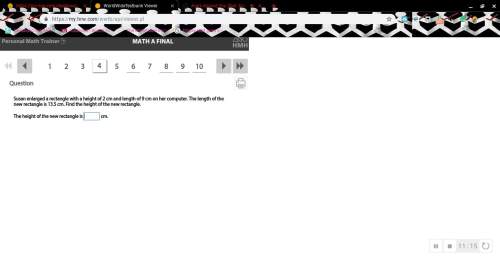
Mathematics, 10.02.2021 09:10 radom2018
Oscar and Maria each wrote an equation that they felt represented the proportional relationship between distance in
kilometers and distance in miles. One entry in the table paired 152 km with 95 miles. If k represents the number of
kilometers and m represents the number of miles, who wrote the correct equation that would relate kilometers to
miles? Explain why.
Oscar wrote the equation k = 1.6m, and he said that the unit rate
1.6
represents kilometers per mile.
1
Maria wrote the equation k = 0.625m as her equation, and she said that 0.625 represents kilometers per mile.

Answers: 2


Other questions on the subject: Mathematics

Mathematics, 21.06.2019 19:00, 4presidents
The distributive property allows you to say that 3(x − 1) = 3x −
Answers: 1

Mathematics, 22.06.2019 00:00, dasiaflowers85
The construction of copying qpr is started below. the next step is to set the width of the compass to the length of ab. how does this step ensure that a new angle will be congruent to the original angle?
Answers: 1

Mathematics, 22.06.2019 02:00, darianhaynes
Study published in the journal of personality and individual differences found that adults with adhd displayed more creative achievement than those who didn't have the disorder. "for the same reason that adhd might create problems, like distraction, it can also allow an openness to new ideas," says holly white, assistant professor of cognitive psychology. "not being completely focused on a task lets the mind make associations that might not have happened otherwise." white and priti shah at the university of michigan gave 60 college students – half of them with adhd – a series of tests measuring creativity across 10 domains. the adhd group scored higher across the board. the adhd group showed more of a preference for brainstorming and generating ideas than the non-adhd group, which preferred refining and clarifying ideas. the adhd status of the participants was established by asking whether the individual had ever been clinically diagnosed with adhd/add. the tests of creativity were pencil-and-paper tasks administered in a laboratory setting. each of the ten scales was comprised of multiple questions, the scores on which were summed (e. g., writing creativity: "how many words can you make from the letters in the word 'psychology' invention creativity: "write down as many uses for a paper clip that you can think of.") this procedure does allow for a participant to be scored as showing no creativity under these conditions. a) state the research question in plain language (i wonder if is related to (1 point) b) state the null hypothesis (1 point) c) state the research hypothesis (1 point) d) is the research hypothesis directional or non-directional (1 point) e) name the predictor / independent variable f) give the operational definition of the predictor / independent variable g) evaluate the construct validity of the predictor / independent variable. (face, procedure, method-match) h) name the outcome / dependent variable i) give the operational definition of the outcome / dependent variable. j) evaluate the construct validity of the outcome / dependent variable. (face, procedure, method-match)
Answers: 1

Mathematics, 22.06.2019 02:40, jake9919
Kilgore trout creates a new scale to diagnose depression. however, his scale only assesses one symptom of depression while ignoring others. which of the following is his new scale most likely lacking? a) test-retest reliability b) discriminant validity c) criterion validity d) alternate-forms reliability e) content validity f) none of the above
Answers: 1
You know the right answer?
Oscar and Maria each wrote an equation that they felt represented the proportional relationship betw...
Questions in other subjects:

Health, 16.07.2019 18:00

English, 16.07.2019 18:00




History, 16.07.2019 18:00



Arts, 16.07.2019 18:00




